Located 325 kilometres west of Melbourne, Portland is regarded as the birthplace of Victoria. Portland has many significant heritage buildings – and you might see a whale while you are there.
The Gunditjmara People
The Dandeyallum clan of the Gunditjmara people occupied the Portland Bay area.
The Gunditjmara also hunted water birds, ducks, plains turkeys, kangaroos and gathered roots, daisy yams and the rhizomes of bracken fern.
A squatter, Thomas Alexander Browne, later described the Eumeralla War in his memoir, Old Melbourne memories, using the pen name Rolf Boldrewood. The Gunditjmara, Browne wrote, were waging “guerilla warfare”.
"We could not permit our cattle to be harried, our servants to be killed, and ourselves to be hunted out of the good land we had occupied by a few savages … Like all guerillas, moreover, their act of outrage took place sometimes in one part of a large district, sometime in another, the actors vanishing meanwhile, and reappearing with puzzling rapidity."
The exact date of this event is uncertain, and some people consider the Convincing Ground massacre to be a myth.
The British
The southern coast of Victoria was first charted by the British Lieutenant James Grant, who sailed to the area on the Lady Nelson in 1800. Grant named Portland Bay in honour of the Duke of Portland, the British Home Secretary, who had sent him on the voyage.
Back in the 1800s, there were large populations of seals in Bass Strait, and so, it was sealing gangs who were probably the next European visitors to the Portland area, as seal skins were worth 21 to 30 shillings each in London. Sadly, this resulted in the seal population greatly declining by the 1830s.
Edward married Anne Marie Gallie and built a Georgian-style mansion called "Burswood", at Portland. His brothers established businesses including the Munthan Pastoral Run of 57,000 acres to the north of the settlement.
Edward Henty arrived at Portland to permanently settle, from Launceston, in November 1834, aboard the Thistle, after a difficult 34-day passage across the Strait.
Major Thomas Mitchell, on his third major survey, led an exploration party which left Sydney in March 1836. They reached Portland Bay on 29 August, and Mitchell, was surprised to find non-Aboriginal people living there. Of Aborignal people, Mitchell later said, "I found those who accompanied me superior in penetration and judgment to the white men composing my party".
Major Mitchell recorded in his journal these powerful words:
"As I stood, the first intruder on the sublime solitude of these verdant plains as yet untouched by flocks and herds, I felt conscious of being the harbinger of mighty changes there; for our steps would soon be followed by the men and the animals for which it seemed to have been prepared."
The Dandeyallum clan of the Gunditjmara people occupied the Portland Bay area.
Portland is the traditional land of Gunditjmara people whose land extended over an estimated 7,000 km2. This group of people built stone dams and eel traps to catch the annual spring eel migration, the remains of which appear to be 3,500 years old (6000?). Also, the remains of basalt block structures which are an average of 3-4 metres across, indicate that the Gunditjmara may have been semi-nomadic, living in huts about one metre high, in a communal setting.
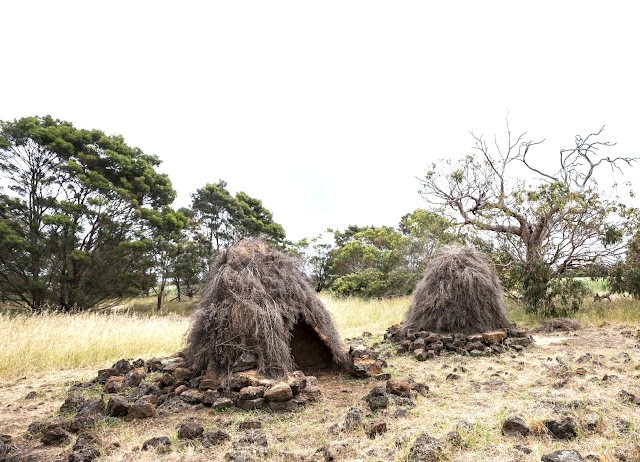 |
| Recreated Gunditjmara houses at Budj Bim Cultural Landscape, VIC Some huts were probably covered with clay |
 |
| The eel traps at the Budj Bim Cultural Landscape, located in the traditional Country of the Gunditjmara people in south-eastern Australia, VIC |
Gunditj- means “belonging,” and -mara is the word for “a local aboriginal person”.
The Gunditjmara had 59 clans, each with a headmen (wungit), a role passed on in a hereditary fashion. Dhauwurd wurrung dialect was spoken in the Portland-Lake Condah area.
The earliest evidence for Aboriginal occupation in the region comes from Bridgewater Cave South, which was first occupied around 11,000 years ago.
There is of course a great diversity in the ways life, cultures, languages and kinship structures among Aboriginal people of Australia.
The Gunditjmara's two moieties are the grugidj (sulphur-crested cockatoo or Long-billed corella) and the gabadj (Red-tailed black cockatoo. Polygamy was practised and some men could have up to ten wives.
 |
| Native encampment at Portland Bay. (1846-47). lithograph, by George French Angas |
Children belonged to their mother’s moiety and girls were betrothed to the opposite moiety in infancy or childhood. Girls were also exchanged.
The recreated stone huts (wuurns) at the Budj Bim Cultural Landscape (40 kms north of Portland), were originally built using stones from lava flows. It is believed that the stones supported a wooden structure that was covered with branches and other vegetation as a "thatch" and at times sealed (or surfaced) with clay. (read more)
Aboriginal people were displaced by European settlers and violent encounters occurred, called the Eumeralla Wars. The most intense period being from 1834 to 1844.
"We could not permit our cattle to be harried, our servants to be killed, and ourselves to be hunted out of the good land we had occupied by a few savages … Like all guerillas, moreover, their act of outrage took place sometimes in one part of a large district, sometime in another, the actors vanishing meanwhile, and reappearing with puzzling rapidity."
Ian D, Clarke wrote in Scars in the landscape: a register of massacre sites in western Victoria, 1803-1859, that:
"In the early months of 1842, approximately 4000 sheep were driven off or destroyed by Aboriginal bands, and four Europeans were killed and two wounded. Attacks were concentrated upon settlers who had occupied land that contained traditional meeting places and sacred sites near Port Fairy, Mt Napier and Lake Condah; areas essential to the political economy of the Aboriginal clans. This campaign of resistance was maintained for several years and effectively slowed the pace of pastoral settlement. During 1844-5, attacks were so frequent that Browne described the hostilities as the "Eumeralla War." In response to the escalation of attacks in 1842, a detachment of the Native Police Corps ..."
"In the early months of 1842, approximately 4000 sheep were driven off or destroyed by Aboriginal bands, and four Europeans were killed and two wounded. Attacks were concentrated upon settlers who had occupied land that contained traditional meeting places and sacred sites near Port Fairy, Mt Napier and Lake Condah; areas essential to the political economy of the Aboriginal clans. This campaign of resistance was maintained for several years and effectively slowed the pace of pastoral settlement. During 1844-5, attacks were so frequent that Browne described the hostilities as the "Eumeralla War." In response to the escalation of attacks in 1842, a detachment of the Native Police Corps ..."
The Gunditjmara, who lived a semi-sedentary lifestyle, became known as "The fighting Gunditjmara", as they waged guerilla warfare against the settlers.
In 1843, the Native Police were brought from Melbourne. These Troopers were recruited mostly from the Kulin Aboriginal clans around Melbourne. It was La Trobe's directive to "take the most decided measures to put a check to these disorders. Violence ensued. However, many Gunditjmara were able to steal a sheep for food and hide in the lava stones and evade the mounted troopers.
 |
| Native Police unit in 1870. Native police were called upon to take part in operations in the Victorian Western District in 1843 |
Lake Condah Mission was established in 1867, close to some of the eel traps and with views of Budj Bim, an important creator being. (High Head), who lived in the volcano that we now call Mt Eccles. Mt Eccles erupted approximately 27,000 – 30,000 years ago. This event changed the landscape, creating the alluvial wetlands and "stony rises" that are evident in this environment today.
The Convincing Ground Massacre
The site called the Convincing Ground in Portland Bay became a whaling station in 1829. However, the tension and disputes that developed between the Gunditjmara people and the whalers over a beached whale, in 1833 or 1834, turned into a massacre.
Edward Henty, who established Victoria's first permanent European settlement, reported to George Augustus Robinson, the chief protector of Aborigines in 1841. He told Robinson that whalers and the Aboriginal people had fought over a whale carcass that had washed up on the beach and that, "The whalers "let fly... right and left upon the natives".
The Convincing Ground site came to public attention in January 2005, when Aboriginal Cultural Heritage Officers stopped the bulldozing of the site for a proposed coastal residential development. This led to the matter becoming a Federal Court Native Title case. The dispute with the residential developer was settled in February 2007 and the decision was made for the Convincing Ground to become a reservation and historical site of frontier conflict.
The site called the Convincing Ground in Portland Bay became a whaling station in 1829. However, the tension and disputes that developed between the Gunditjmara people and the whalers over a beached whale, in 1833 or 1834, turned into a massacre.
Edward Henty, who established Victoria's first permanent European settlement, reported to George Augustus Robinson, the chief protector of Aborigines in 1841. He told Robinson that whalers and the Aboriginal people had fought over a whale carcass that had washed up on the beach and that, "The whalers "let fly... right and left upon the natives".
The Convincing Ground site came to public attention in January 2005, when Aboriginal Cultural Heritage Officers stopped the bulldozing of the site for a proposed coastal residential development. This led to the matter becoming a Federal Court Native Title case. The dispute with the residential developer was settled in February 2007 and the decision was made for the Convincing Ground to become a reservation and historical site of frontier conflict.
The British
The southern coast of Victoria was first charted by the British Lieutenant James Grant, who sailed to the area on the Lady Nelson in 1800. Grant named Portland Bay in honour of the Duke of Portland, the British Home Secretary, who had sent him on the voyage.
French explorer, Nicolas Baudin, charted the South Australian coastline at the same time as British navigator, Matthew Flinders, in 1802. The French explorer, Nicholas Baudin, named the area Terra Bonaparte.
 |
| British explorer Matthew Flinders was the first person to circumnavigate Australia, Sydney Mail (NSW : 1912 - 1938) |
The seasonal community of sealers from 1803, were a multi-cultural group. One sealing crew (based in Hobart) was mostly Maori. There were also Americans, both white and black, and Aboriginal and mixed-race whalers and sealers, as well as those of British ancestry and born here.
1820s
William Dutton
William Dutton, who was most likely the first European settler of Portland, was responsible for harpooning one of the very first whales in Portland Bay; he also killed the very last whale here. Born in Sydney, Dutton lived at Portland, on and off, since 1829, when he built his first house there in July of that year. Dutton also camped at near Blacknose Point. He was, however, often absent during the whaling and sealing seasons.
William Dutton, who was most likely the first European settler of Portland, was responsible for harpooning one of the very first whales in Portland Bay; he also killed the very last whale here. Born in Sydney, Dutton lived at Portland, on and off, since 1829, when he built his first house there in July of that year. Dutton also camped at near Blacknose Point. He was, however, often absent during the whaling and sealing seasons.
1830s
Portland: An Unauthorised Settlement
The Whaling Station
In the 1830s, Dutton oversaw the establishment of a "whaling colony" in Portland, which became a successful industry in the Portland area from the early 1830s, to the late 1840s. A boiling down factory for whale blubber was set up in March 1833, and Portland became the first permanent European settlement in Victoria.
In the 1830s, Dutton oversaw the establishment of a "whaling colony" in Portland, which became a successful industry in the Portland area from the early 1830s, to the late 1840s. A boiling down factory for whale blubber was set up in March 1833, and Portland became the first permanent European settlement in Victoria.
According to the Heritage Council, there are 19 shipwrecks in Portland Bay. These vessels carried immigrants and all manner of cargoes, including timber, whaling products, potatoes, clothing, alcohol and pianos. Most wrecks have never been located. The small schooner Henry is the first recorded shipwreck in Portland Bay, when it was forced ashore while loading whale oil in August 1834.
Edward Henty
Edward Henty, who had immigrated from England to Tasmania visited William Dutton at Portland in 1833 and was so impressed with the area that he moved there permanently in the following year. Henty and his brothers also settled in the Portland district and became involved in whaling and built successful businesses.
Edward Henty, who had immigrated from England to Tasmania visited William Dutton at Portland in 1833 and was so impressed with the area that he moved there permanently in the following year. Henty and his brothers also settled in the Portland district and became involved in whaling and built successful businesses.
He said, "I stuck a plough into the ground, struck a she-oak root, and broke the point ; cleaned my gun, shot a kangaroo, mended the bellows, blew the forge fire, straightened the plough, and turned the first sod in Victoria".
This simple, single-furrow plough, pulled by a bullock team, had a "mouldboard and share". The iron work was made in Uddington, Scotland, and the beam, made from Australian hardwood, was attached by Henry.
 |
| Jane Henty (1817–1906), née Pace, is believed to be the first European woman to settle permanently in Victoria. Punch (Melbourne, Vic. : 1900 - 1918; 1925), Thursday 7 May 1914 |
Major Mitchell recorded in his journal these powerful words:
"As I stood, the first intruder on the sublime solitude of these verdant plains as yet untouched by flocks and herds, I felt conscious of being the harbinger of mighty changes there; for our steps would soon be followed by the men and the animals for which it seemed to have been prepared."
Mitchell was also astonished to see a thriving town being visited by ships and engaged in the whaling industry, with sealers from many parts of the world. Portland was an unauthorised settlement. However, in 1840, Portland was officially surveyed and later that year, the sale of land began.
In 1839, the first police magistrate of Geelong, Foster Fyans, was sent by NSW Governor Gipps to Portland to investigate claims about maltreatment and violence against Aboriginal people by the whalers and Henty brothers. The Henty's were cleared of such charges.1840s
The site at the corner of Bentinck and Julia Streets, Portland, was purchased by S. G. Henty in October 1840. Sometime between 1842 and 1846, Henty constructed a single-storey stone building, which he licensed in 1847, as the London Inn. In the early 1850s, a second-storey and alterations to the facade were completed.
A tannery was established by Walter Birmingham in 1842, on the beach where the current Port of Portland Authority’s headquarter buildings is located.
The first public baths were built in 1858, at the end of Henty Street.
The construction of the railway began in 1874 with Portland North station becoming the terminus.
In the mid-1880s, the Gordon Hotel located at 63 Bentinck Street, Portland, included a Cobb and Co booking office.
1890s
1900s
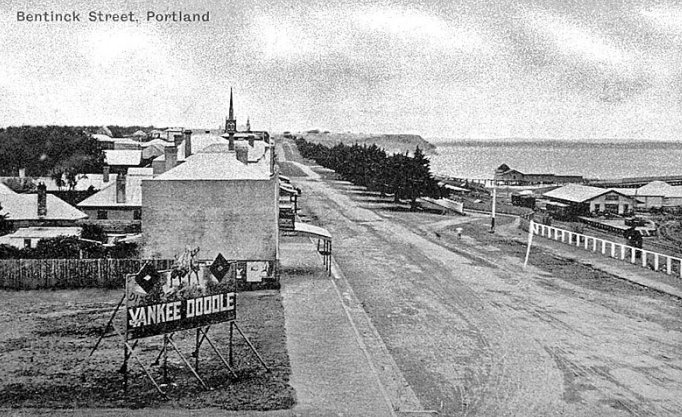
Bentinck Street looking North from Gawler Street, Portland Victoria
WWI
1940s and WWII
Reg Saunders served with the 6th Australian Division in the North African and the Greek campaigns, in WWII and later, served as a company commander during the Korean War.
Whilst living in Portland, Victoria, Reg went into business in 1937, in the operation of a sawmill. However, the business was destroyed in a bushfire in 1939.
Most of Portland's population was involved in the lucrative but short-lived whaling industry, which fell into decline in the early 1840s.
Charles Tyers completed the survey of the Portland Township and harbour, at the end of 1840.
Portland is a natural deepwater port. A jetty was built in 1846 and later replaced with more substantial and efficient piers and breakwaters.
1850s
Then the town's fortunes went into decline until the Victorian gold rushes invigorated business interests in the 1850s, when thousands of hopeful diggers arrived at the port and passed through the town to buy equipment as they headed off to the goldfields.
After the gold rush subsided, the businesses in the town of Portland and nearby Port Fairy, suffered as many people were drawn to the growing town of Melbourne. However, in the 19th century, Portland became an important fishing port and then, an industrial port. The area also began to attract tourists, who were drawn to the region's volcanic cliffs, pristine beaches and historical buildings.
 |
| Union Bank, Portland, Victoria. Circa 1858. State Library of VIC |
 |
| Dr Grier's residence, Julia St. 1859, Portland, VIC |
 |
| Messrs Trangmar & Crouch's store, 1859, Portland, VIC |
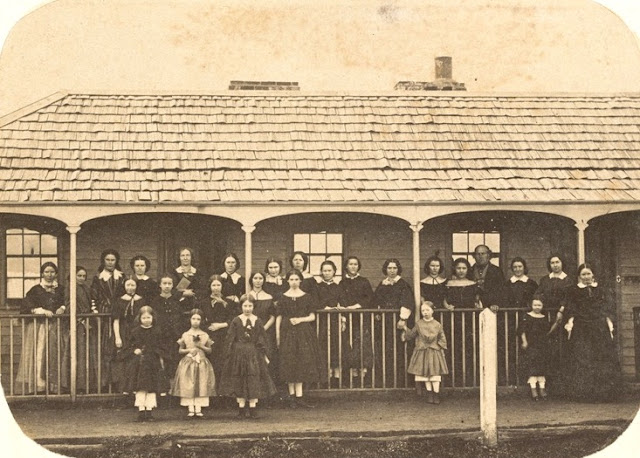 |
| Miss Clarke’s Seminary, Portland, (detail) circa 1859, SLVIC |
 |
1860s
The last whale was harpooned in Portland in 1868, by William Kirkham and lanced by Dutton.
The last whale was harpooned in Portland in 1868, by William Kirkham and lanced by Dutton.
1870s
1880s
The Cape Nelson lighthouse, completed in 1884, served ships at sea navigating the treacherous coastline of the Portland area.
The London Inn was operated by Oliver Dolphin, who arrived in Portland in late 1888 and lived in the town for about six years. In that time, he became a councillor with the Portland Council and the chairman of the Portland Cricket Club. Dolphin even managed to perform concerts with his musical group called the Buffalo Minstrels.
 |
| Builder's Arms Hotel, Portland, Victoria, 1890-1900. State Libray of VIC |
 |
| "Negative - Staff of H. Drew 's Builder's Arms Hotel, Portland, Victoria, circa 1880"by Creator: C Gribble Studio is marked with CC PDM 1.0 |
 |
| Dolphin's London Hotel, Portland Victoria, circa 1880. State Library of VIC |
Vida Goldstein
Vida Jane Mary Goldstein (1869 –1949), was a feminist and suffragist who was born in Portland. Her father was of Polish Jewish origin and her mother, the daughter of a Scottish-born squatter.
in 1891, Vida helped her mother to collect signatures for the Monster Petition for women's suffrage. In 1899, she became the leader of the women's suffrage movement in Victoria.
Vida Jane Mary Goldstein (1869 –1949), was a feminist and suffragist who was born in Portland. Her father was of Polish Jewish origin and her mother, the daughter of a Scottish-born squatter.
in 1891, Vida helped her mother to collect signatures for the Monster Petition for women's suffrage. In 1899, she became the leader of the women's suffrage movement in Victoria.
 |
| FARR'S LIVERY STABLE, PORTLAND, VICTORIA - December 1903, Aussie~mobs |
 |
| Portland Post Office, VIC. Australasian (Melbourne, Vic. : 1864 - 1946), Saturday 28 July 1906 |
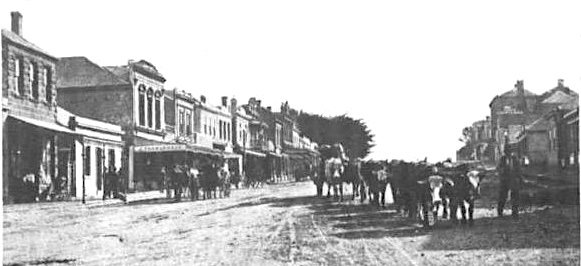 |
| Julia Street, Portland, VIC. Australasian (Melbourne, Vic. : 1864 - 1946), Saturday 28 July 1906 |
 |
| Portland Ladies Rifle Club, VIC, Australasian (Melbourne, Vic. : 1864 - 1946), Saturday 28 July 1906 |
 |
| Portland Freezer Works, VIC, Australasian (Melbourne, Vic. : 1864 - 1946), Saturday 29 February 1908 |
 |
| Bentinck Street Portland VIC, 1908. State Library of VIC |
 |
| "Negative - Portland, Victoria, 1910" by Creator: Clark Bros Studio is marked with CC PDM 1.0 |
 |
| Saw Mill at North Portland, VIC. Weekly Times (Melbourne, Vic. : 1869 - 1954), Saturday 5 March 1910 |

Bentinck Street looking North from Gawler Street, Portland Victoria
 |
| "Negative - Portland, Victoria, 1915" is marked with CC PDM 1.0 |
WWI
The Cape Nelson lighthouse was used in World War I as it possessed a powerful telescope and telephone connections.
 |
| "Negative - New Pier, Portland, Victoria, 1921" by Creator: James Batson is marked with CC PDM 1.0 |
 |
| Bentinck St, Portland, VIC, circa 1922 |
"As a summer resort it is. becoming more
appreciated every season.' In 1922 when I
had the pleasure of spending several months
there, Mac's Hotel, the leading hostelry, was
credited with having refused 300 would-be
clients owing to the rush of visitors. One
retired sugar plutocrat from Queensland was
paying £40 a week for accommodation for
his wife and family for three months at this
hotel. "
Portland Guardian (Vic. : 1876 - 1953) Thu 27 Mar 1924
appreciated every season.' In 1922 when I
had the pleasure of spending several months
there, Mac's Hotel, the leading hostelry, was
credited with having refused 300 would-be
clients owing to the rush of visitors. One
retired sugar plutocrat from Queensland was
paying £40 a week for accommodation for
his wife and family for three months at this
hotel. "
Portland Guardian (Vic. : 1876 - 1953) Thu 27 Mar 1924
The Star Theatre opened on 7th November 1925.
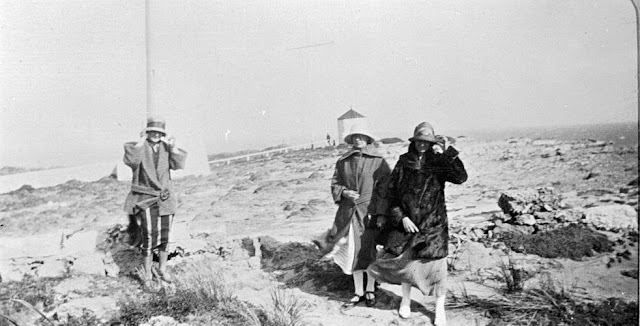 |
| Three Women at the Lighthouse, Cape Nelson, Victoria, 1925, Museum Victoria |
 |
| Ford Motor Car Drawn Up in Front of the 'Maritimo' Guesthouse, Portland, Victoria, Jan 1928, by Creator: S Pollard |
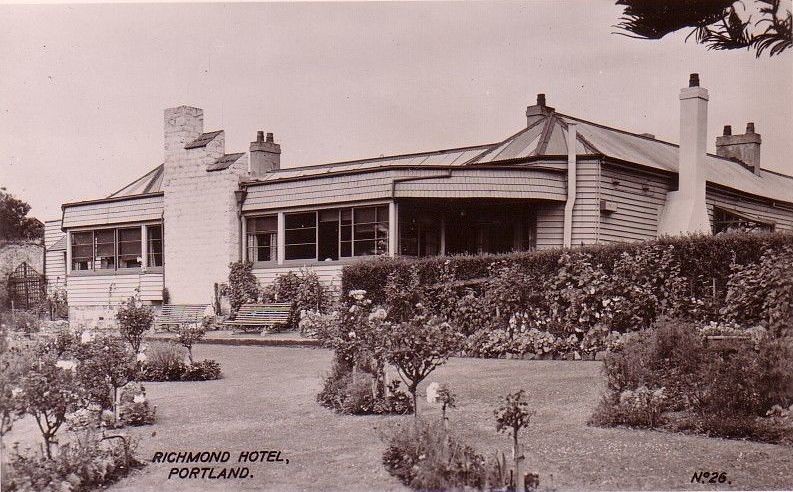 |
| "Burswood" Edward Hentys house and later the Richmond Hotel, Portland, Victoria. Aussie Mobs |
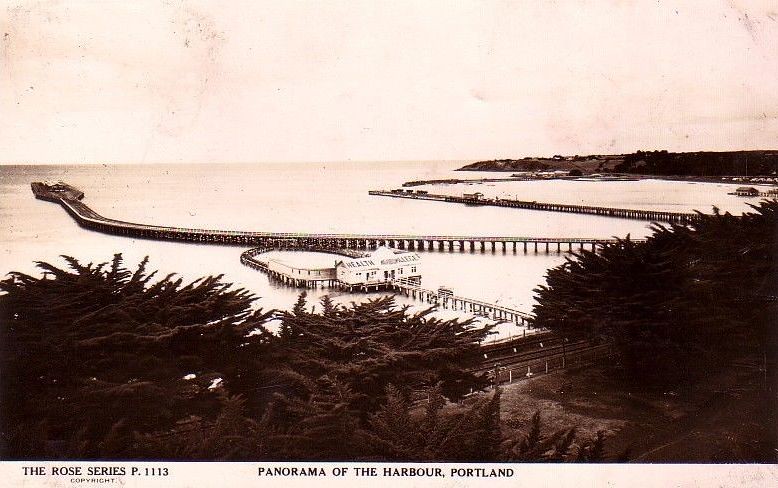 |
| Panorama of the Harbour, Portland, Victoria, Australia, Aussie Mobs |
1930s
 |
| Macs Hotel, Portland, VIC; perhaps, Victoria's centenary celebrations, in November 1934 |
 |
| When the Duke Visited Portland :Pioneering Days Re-enacted The centenary of Portland, VIC. Sydney Mail (NSW : 1912 - 1938), Wednesday 28 November 1934 |
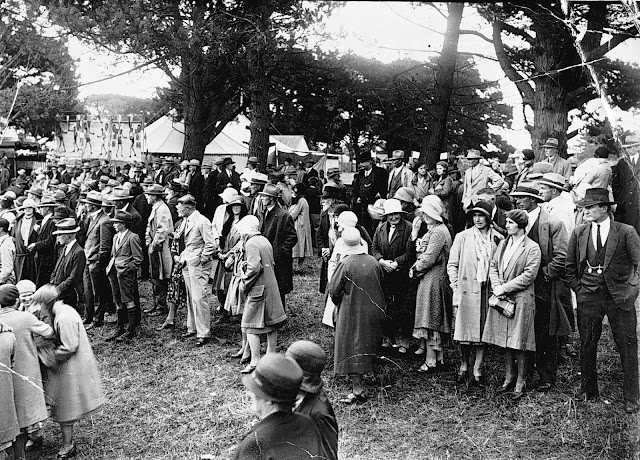 |
| "Negative - Portland, Victoria, pre 1935" is marked with CC PDM 1.0 |
 |
| Gordon Hotel, VIC, n.d. |
 |
| "Negative - Three Women Riding Camels on the Beach, Portland, Victoria, circa 1935" is marked with CC PDM 1.0 |
 |
| A busy scene, shipping wheat at the Deep Water Pier, Portland, Victoria, Australian National Maritime Museum on The Commons |
During World War 11, the Cape Nelson Lighthouse was used as a radar station and support camp, which could issue warnings about Japanese vessels and aircraft.
Reginald Walter "Reg" Saunders
Reginald Walter "Reg" Saunders, MBE (1920 – 1990), who came from a military family (his father, Chris Saunders served with the 10th Machine Gun Battalion on the Western Front in the First World War), was the first Aboriginal Australian to obtain the rank of officer in the Australian Army. He was named after his uncle, William Reginald Rawlings, who had been awarded the Military Medal for bravery on the Western Front, only a month before he was killed in action in 1918, aged 27.
Reg Saunders served with the 6th Australian Division in the North African and the Greek campaigns, in WWII and later, served as a company commander during the Korean War.
Whilst living in Portland, Victoria, Reg went into business in 1937, in the operation of a sawmill. However, the business was destroyed in a bushfire in 1939.
According to a book called, Forged By War, Reg Saunders had Gunditjmara and Jawoyn ancestry, as well as Jamaican, Cornish and Sri Lankan. But sadly, although, he served his country and received the highest honours, he was never awarded land as part of soldier settlement, like many other soldiers of the time. Though, he dreamed of owning his own farm.
Portland goes from a borough to a town in 1949.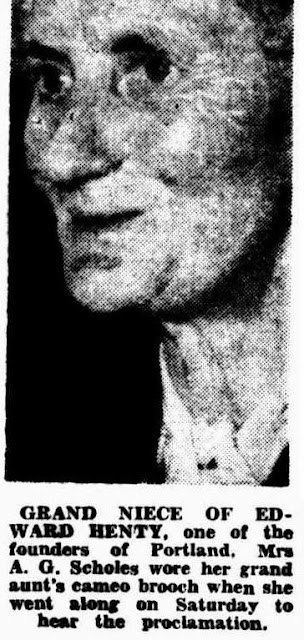 |
| Grand niece of Edward Henty, Argus (Melbourne, Vic. : 1848 - 1957), Monday 21 November 1949 |
1950s

Henry CWA Coronation ball at Portland, VIC, Weekly Times (Melbourne, Vic. : 1869 - 1954), Wednesday 15 July 1953
1980s

Henry CWA Coronation ball at Portland, VIC, Weekly Times (Melbourne, Vic. : 1869 - 1954), Wednesday 15 July 1953
 |
| Bentinck Street Looking South, Portland, Vic, about 1954. State Library of VIC |
 |
| Gordon Hotel, Portland, VIC, about 1950s, SLVIC |
1980s
The Portland aluminium smelter was commissioned between 1986 and 1988.
In Portland's Henty Park enclsoed by cyclone fencing sits the town's former geothermal system, which was constructed in 1983, and was unique in the world. Closed in 2006.
Portland Maritime Discovery Centre
Portland Powerhouse Motor & Car Museum
Gardens Cottage
History House (Old Town Hall) Portland
Portland 1889 Battery
Portland Rocket Shed
2014
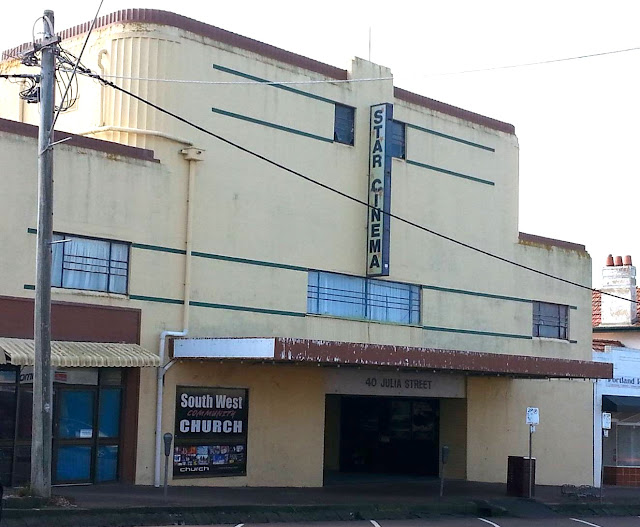 |
| Star Cinema, Percy Street, Portland, VIC, in 2014 |
Around Town
 |
| Built in 1876 - 77 as a meeting hall by the local Freemason Lodge, Portland, victoria |
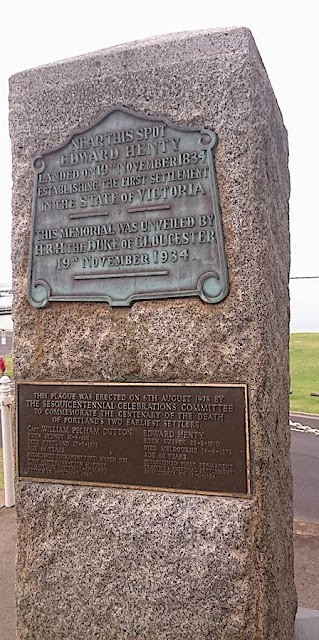 |
| A monument commorating Edward Henty and his brothers |
| Bayview College, Portland, Victoria. History |
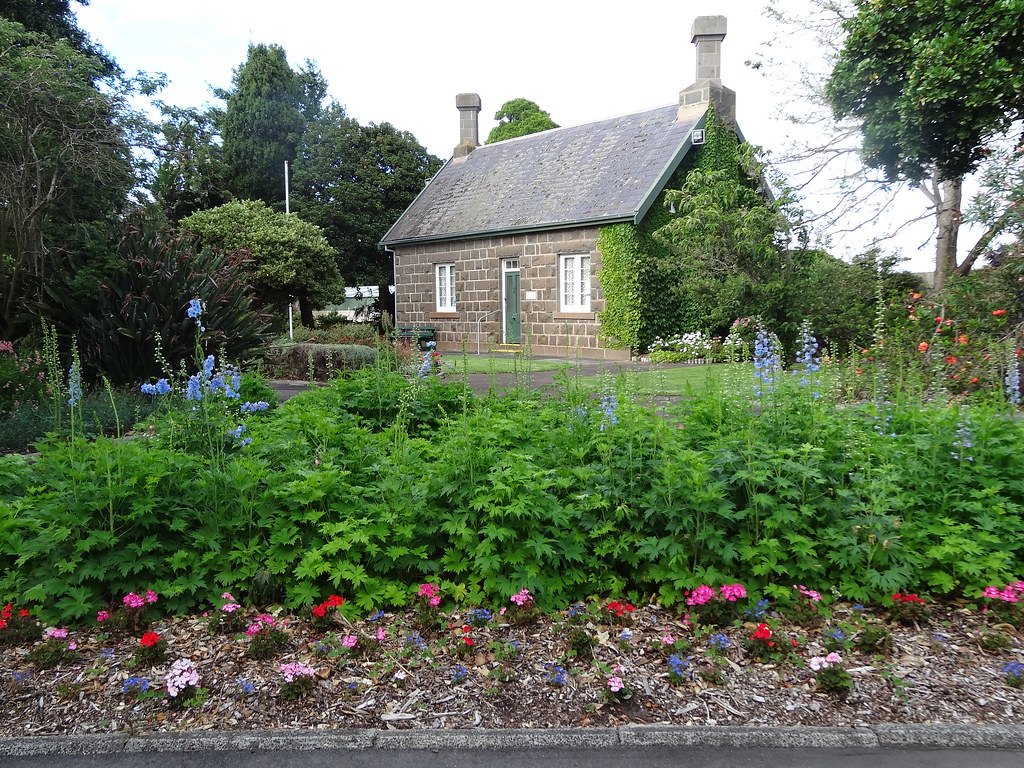 |
| The Botanic Gardens. The Curators Cottage was built from blue basalt in 1858. Denisbin |
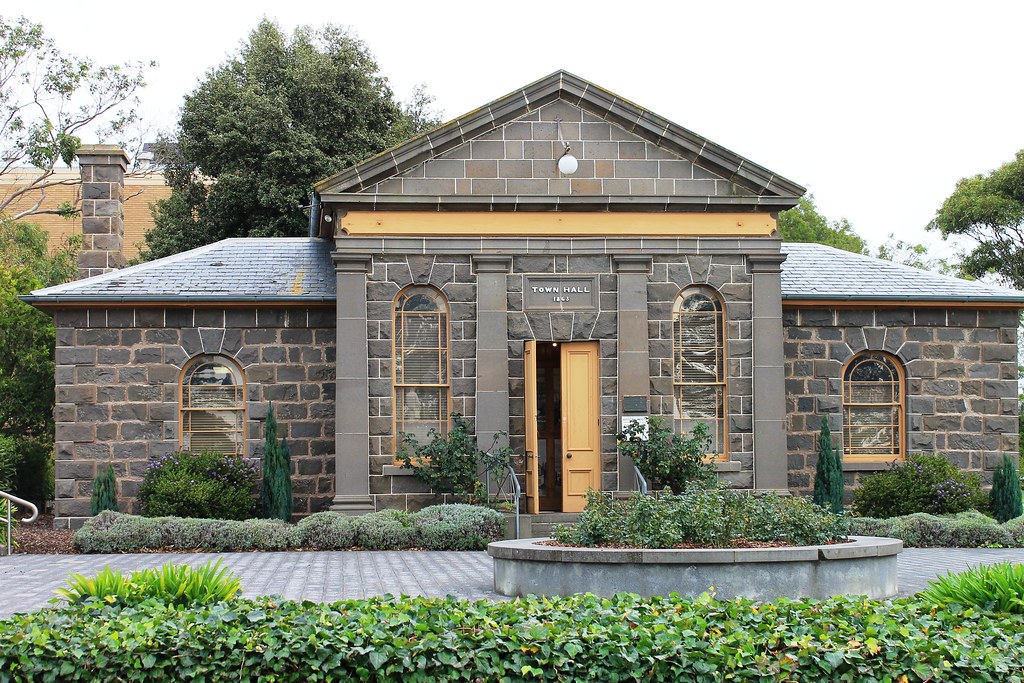 |
| The original Portland Town Hall, built 1863. Mertie |
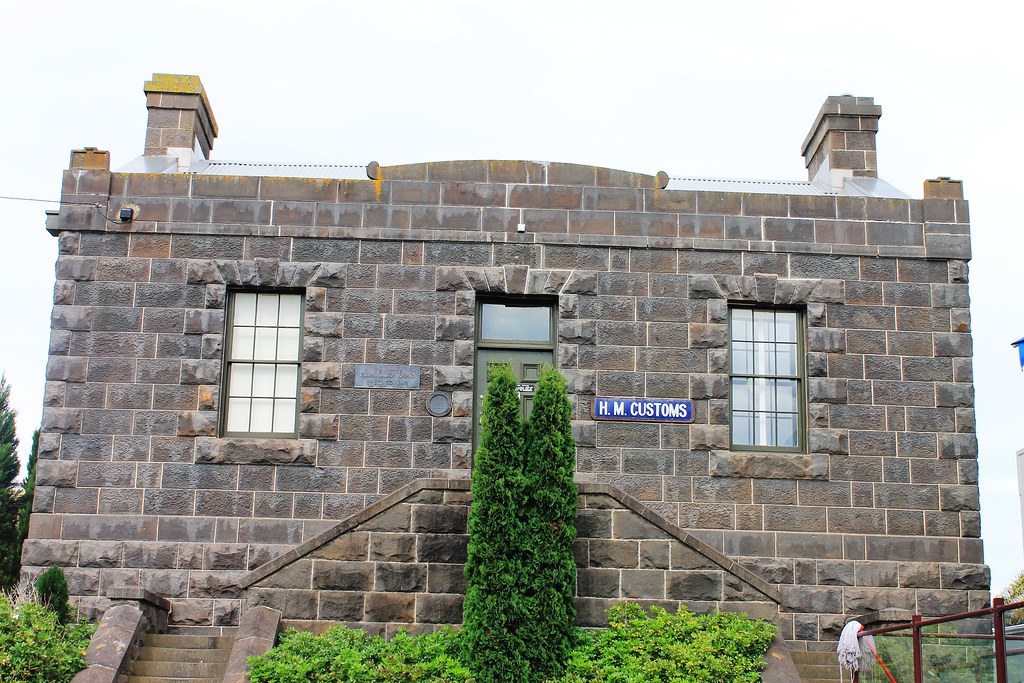 |
| Original Custom's house, Portland, Victoria, built 1849-1850. Mertie |
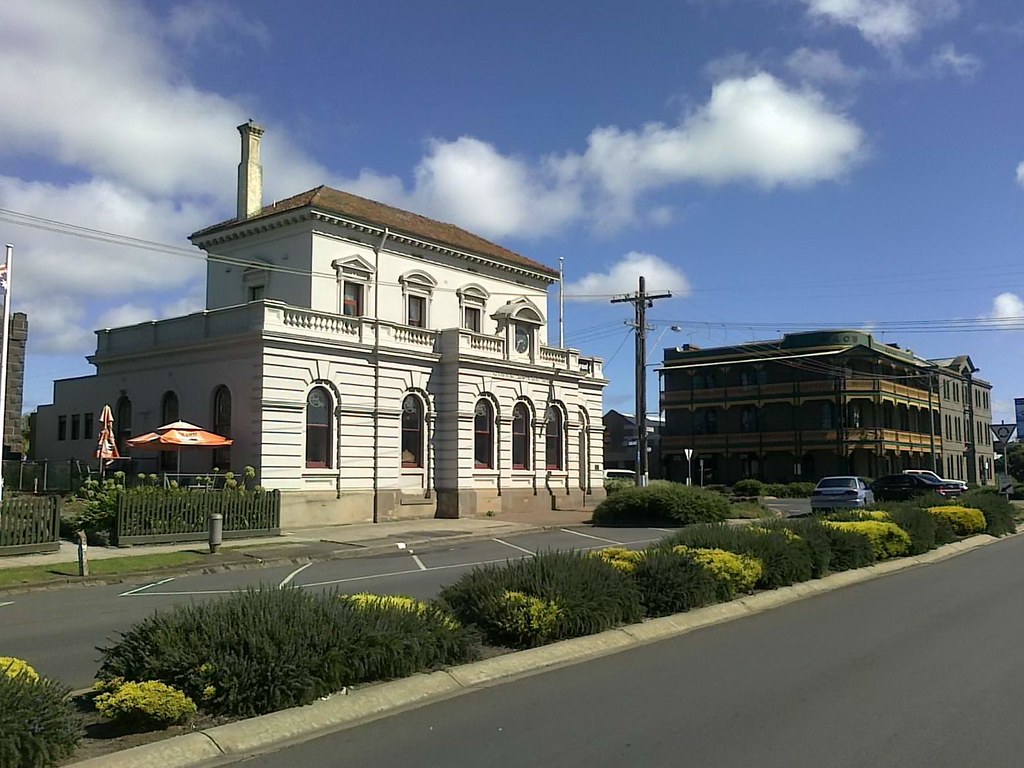 |
| The Old Portland Post Office & Mac's Hotel. Warrem Mars |
 |
| Crompton House, Portland, Victoria. Gordon Chirgwin |
 |
| Portland Battery was constructed in 1889 to defend Victoria against a feared Russian invasion |
 |
| Whalers Buff Lighthouse originally built at Battery Point in Portland in 1859 and relocated to Whalers Point in 1889 |
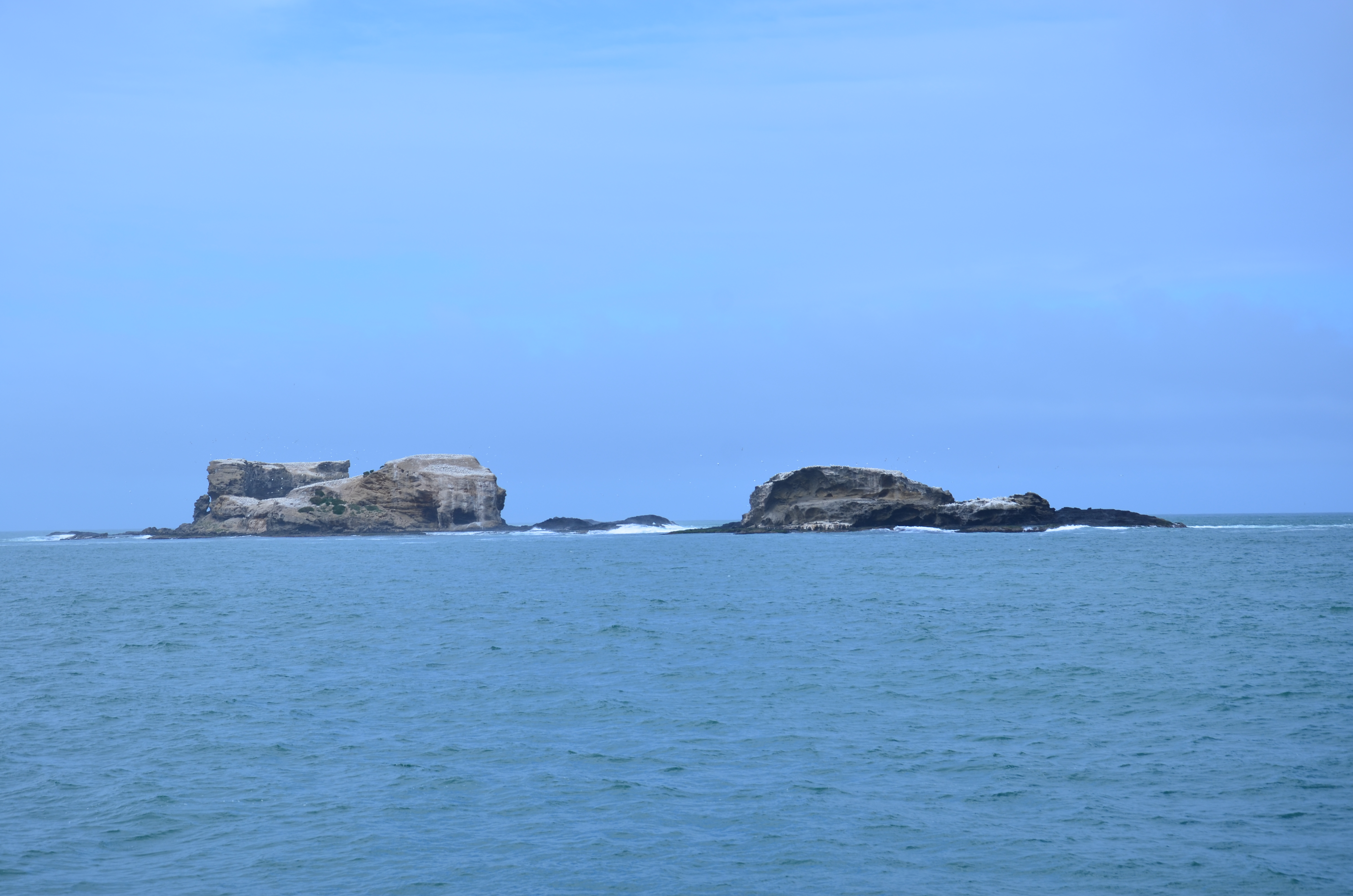 |
| Lawrence Rocks , about 6 km south-east of the city of Portland, Victoria |
 |
| View of Portland Costal Parl, Victoria |
 |
| Julia St, Portland, VIC |
 |
| The Mac’s Hotel Bentinck Street, completed in February 1856 |
 |
| Two storey Georgian style house in basalt built in 1873 for a ships doctor Dr Grier. Denisbin |
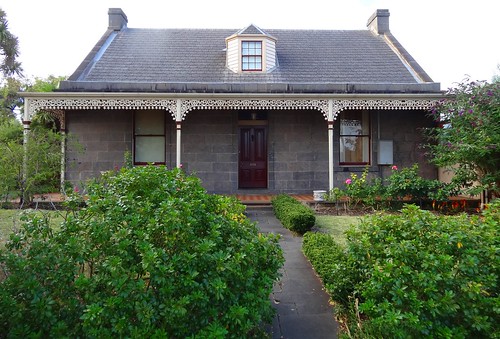 |
| Bluestone house (1854), Portland, VIC, built by Samuel Hawkins for his brother James. Samuel Hawkins was the Grandfather of Vita Goldstein, Suffragette and 1st woman to stand for Parliament in the British Empire. denisbin |
 |
| Wando Villa at Portland, VIC, was constructed in 1864 for major Alexander Davidson, a Scottish born pastoralist |
 |
| Grave of Captain William Pelham Dutton, one of the earliest settlers in Portland Bay, at Narrawong Public Cemetery |
 |
| The London Inn, corner of Bentinck and Julia Streets, Portland |
 |
| Cape Nelson Lighthouse cottage, Portland VIC |
 |
| "Avonmore", Portland, VIC, was built in the 1870s, for George Yelverton Wilson and named for his ancestral family home in Ireland |
 |
| 7 Julia Street, old bluestone store (1854) in front of an 1840s buildings, Portland, VIC |
 |
| The Former Builders' Inn at 25 Gawler Street is one of Portland's earliest hotels. A license was granted to John Leahy for the Builders Inn in 1849, Portland, VIC |
 |
| “Sandilands” located at 33 Percy Street was built in the early 1850s for Portland doctor William S. Sutherland, VIC |
Things To Do and Places To Go











.jpg)








